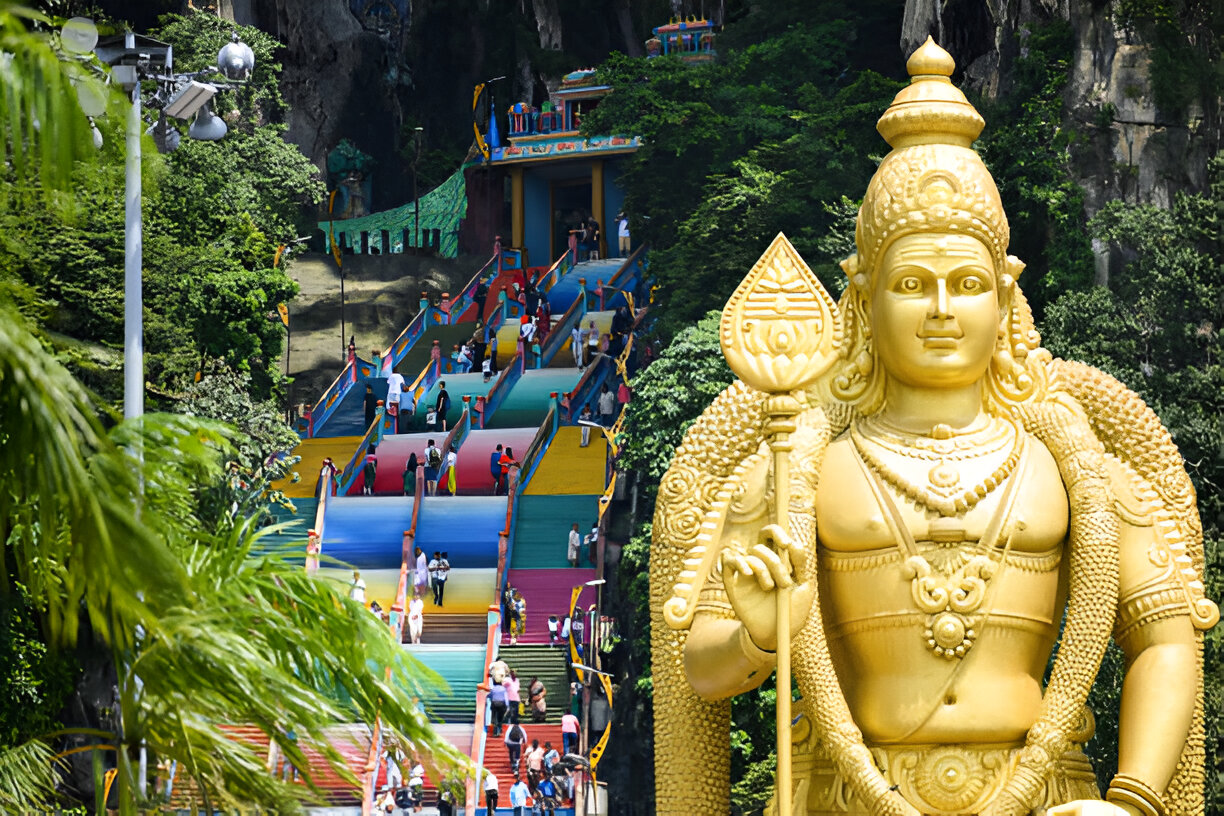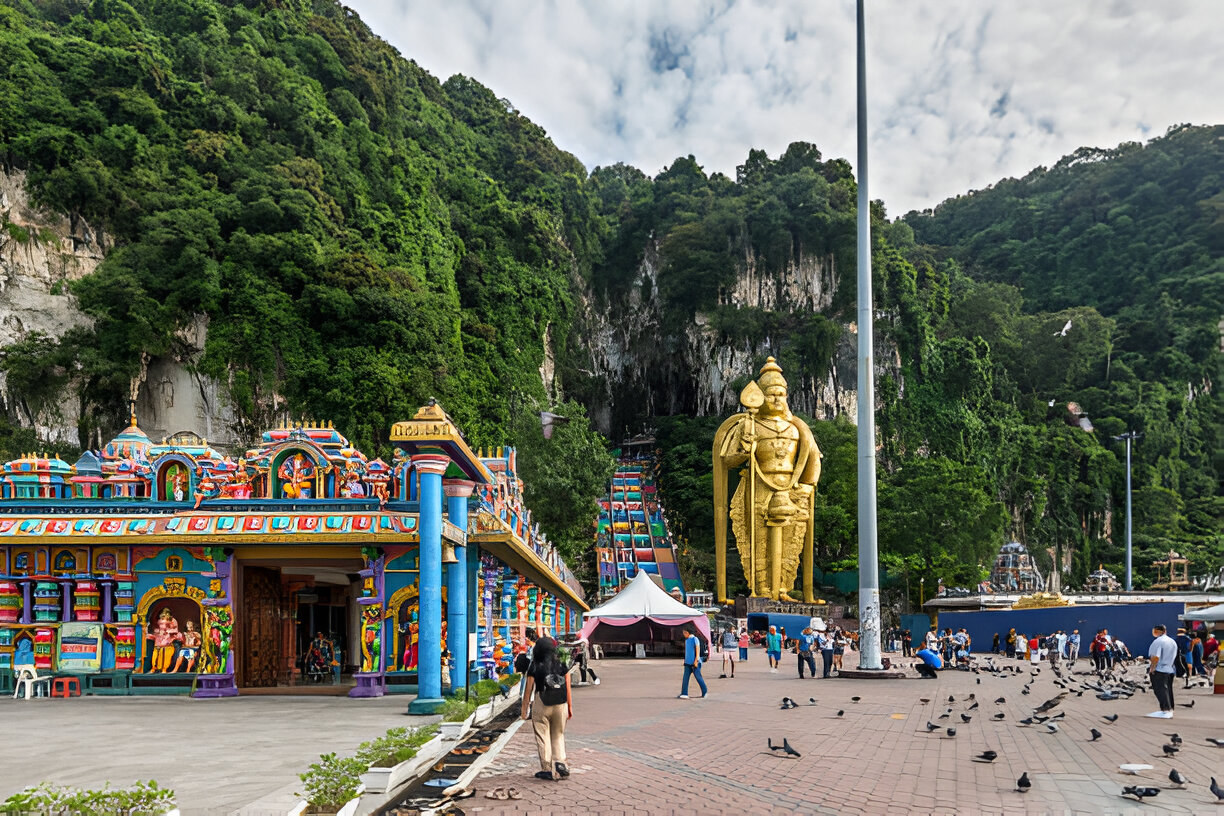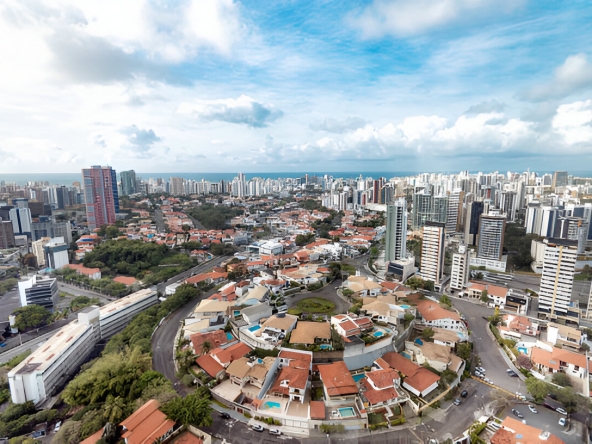Situated just a short drive from Kuala Lumpur, the Batu Caves are one of Malaysia’s most iconic and revered landmarks. This natural wonder combines stunning limestone caves with rich cultural and religious significance, offering visitors a unique glimpse into Hindu spirituality and Malaysian heritage. Here’s everything you need to know to fully experience the Batu Caves, including its awe-inspiring statue of Lord Murugan and the beautiful temples nestled within the caves.
1. Overview of Batu Caves

The Batu Caves are a series of limestone caves and cave temples located in Gombak, just north of Kuala Lumpur. The site consists of three main caves and several smaller ones, situated within a towering limestone hill. The caves have been a major pilgrimage site for Hindus, particularly during the annual Thaipusam Festival, which attracts thousands of devotees from around the world.
2. The Iconic Statue of Lord Murugan
At the entrance to the Batu Caves stands the colossal statue of Lord Murugan, a revered Hindu deity. This statue, standing at an impressive 42.7 meters (140 feet), is one of the tallest statues of a Hindu deity in the world. Crafted from 300 liters of gold paint, the statue is a striking sight, symbolizing Lord Murugan’s role as the protector and deity of the caves.
- Photo Opportunity: The statue is best viewed from the base of the hill where you can capture its grandeur against the backdrop of the surrounding limestone cliffs.
3. The Main Caves: Temple Cave
The Batu Caves complex is comprised of several caves, but the most significant is the Temple Cave. This main cave is a vast chamber adorned with Hindu shrines and statues dedicated to various deities, including Lord Murugan. To reach the Temple Cave, visitors must climb a steep flight of 272 steps.
- Climbing Tips: The ascent can be challenging, especially in the tropical heat, so wear comfortable clothing and sturdy shoes. Carry a water bottle to stay hydrated and take breaks as needed.
4. The Dark Cave
Another notable cave in the Batu Caves complex is the Dark Cave. This cave is not a religious site but an important ecological area home to unique cave fauna and impressive geological formations. The Dark Cave offers guided tours that delve into its natural history and conservation efforts.
- Tour Tip: Wear appropriate footwear and be prepared for a slightly rugged terrain. Guided tours offer fascinating insights into the cave’s ecosystem and are a great way to learn more about its natural features.
5. The Cave Villa
The Cave Villa is a more recent addition to the Batu Caves complex. This attraction features a blend of Hindu art and cultural exhibits, showcasing intricate statues, paintings, and carvings that provide deeper insights into Hindu traditions and mythology. It also includes a cultural museum and craft village, where you can purchase traditional Indian crafts and souvenirs.
6. Cultural and Religious Significance
The Batu Caves hold deep spiritual and cultural significance for Hindus. The site is especially important during the Thaipusam Festival, which celebrates the triumph of good over evil. During this festival, devotees undertake a rigorous pilgrimage to the Batu Caves, often carrying elaborate kavadis (burdens) as acts of penance and devotion.
- Festival Tip: If visiting during Thaipusam (usually in January or February), be prepared for large crowds and vibrant processions. It’s a unique opportunity to witness a significant cultural and religious event.
7. Practical Information for Visitors
- Opening Hours: The Batu Caves are open daily from 6:00 AM to 9:00 PM. The Dark Cave tours have specific timings, so check in advance if you plan to visit it.
- Entrance Fee: Access to the Batu Caves is free. However, there is a nominal fee for the Dark Cave tours and for certain attractions within the Cave Villa.
- Getting There: The Batu Caves are accessible by car, taxi, or train. The KTM Komuter train from Kuala Lumpur’s city center takes you directly to Batu Caves Station, which is a short walk from the caves.
- Local Tips: Respect the religious customs and traditions when visiting the Batu Caves. Dress modestly, cover your shoulders, and remove your shoes before entering the temple areas.
8. Nearby Attractions
While the Batu Caves are a destination in their own right, you might also explore nearby attractions, including:
- Kuala Lumpur Bird Park: A short drive from Batu Caves, this park is home to a diverse range of bird species and offers interactive bird experiences.
- Gombak Caves: Located in the same region, these caves offer additional cave exploration opportunities and are less crowded than Batu Caves.
- Kuala Lumpur City Center: After visiting the Batu Caves, you can return to the city center to explore other landmarks such as the Petronas Twin Towers, KLCC Park, and Bukit Bintang for shopping and dining.
A visit to the Batu Caves offers a captivating blend of natural beauty, religious significance, and cultural heritage. From the towering statue of Lord Murugan to the intricate temples within the caves, the Batu Caves provide a unique glimpse into Hindu spirituality and Malaysian culture. Whether you’re climbing the steps to the Temple Cave, exploring the natural wonders of the Dark Cave, or learning about Hindu traditions at the Cave Villa, the Batu Caves promise an unforgettable experience that reflects the rich tapestry of Malaysia’s diverse cultural landscape.







